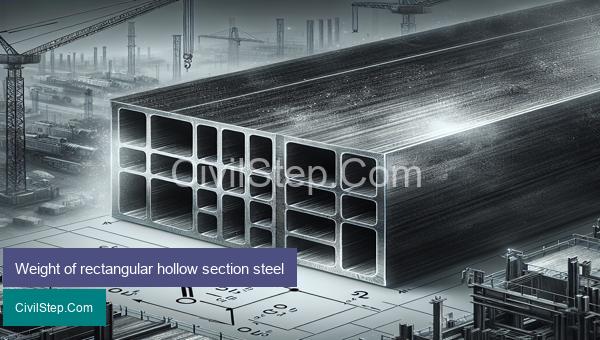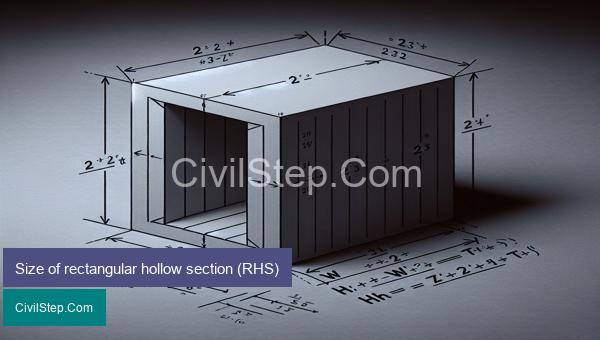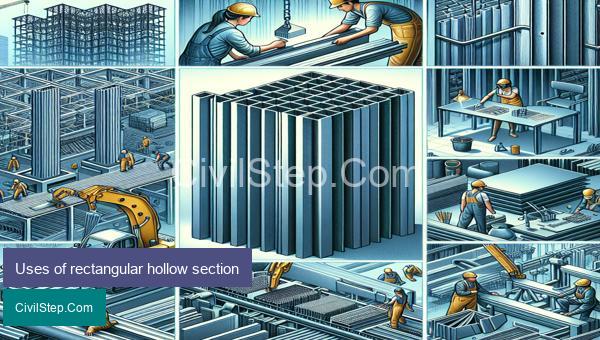
Steel is one of the most widely used materials in construction, known for its strength, durability, and versatility. Among the various types of steel used in construction, rectangular hollow section (RHS) steel is a popular choice for many projects. Its unique shape and design offers several advantages over traditional solid steel sections. However, the weight of RHS steel can vary significantly depending on its dimensions and properties. In this article, we will delve into the details of the weight of rectangular hollow section steel, exploring its various factors and how it impacts construction projects.
Weight of rectangular hollow section steel

The weight of a rectangular hollow section (RHS) steel is an important factor to consider in structural design and construction projects. RHS steel is commonly used in building frames, bridges, and other structures due to its strength, durability, and cost-effectiveness.
The weight of a RHS steel is determined by its dimensions, thickness, and the type of steel used. The following are the factors that affect the weight of a rectangular hollow section steel:
1. Dimensions: The weight of a RHS steel is directly proportional to its dimensions. This means that a larger RHS steel will weigh more than a smaller one, given that all other factors are equal. The dimensions of RHS steel are usually specified in terms of its outside width, outside height, and wall thickness.
2. Thickness: The weight of RHS steel is also influenced by its thickness. A thicker wall will result in a heavier weight, as it requires more material to construct. This is why thicker RHS steel is used for applications that require high strength and load-bearing capacities.
3. Type of steel: The weight of RHS steel also depends on the type of steel used. Commonly used types of steel for RHS include carbon steel, stainless steel, and alloy steel. The weight of these different types of steel can vary due to their different chemical compositions and material properties.
The weight of a RHS steel can be calculated using its volume and density. The volume of a RHS steel can be determined by multiplying its cross-sectional area (width x height) by its length. The density of steel is generally around 7850 kg/m³ (490 lb/ft³).
A basic formula for calculating the weight of RHS steel is:
Weight (kg) = Volume (m³) x Density (kg/m³)
= (width x height x length) x 7850
= (W x H x L) x 7850
Where:
W = width of RHS steel (mm or in.)
H = height of RHS steel (mm or in.)
L = length of RHS steel (mm or ft.)
The weight of RHS steel can also be determined by using online weight calculators or referencing steel weight charts provided by manufacturers.
In conclusion, the weight of a rectangular hollow section steel is influenced by its dimensions, thickness, and type of steel. Accurate calculation of the weight of RHS steel is essential for designing safe and efficient structures. Consultation with a professional engineer is recommended for accurate structural design and material selection.
manufacturing process

Manufacturing process is the series of steps involved in the production of goods or products. This process involves converting raw materials into finished products by using various methods, techniques, and equipment. Civil engineering is a field that relies heavily on different manufacturing processes to design, construct, and maintain various infrastructures.
The manufacturing process starts with the selection of the right materials. In civil engineering, raw materials such as aggregates, cement, steel, and water are essential elements in the construction process. These materials are carefully chosen based on their quality, strength, and durability to ensure the structural integrity of the final product.
After the materials are selected, they go through the mixing process. This process involves combining the materials in a specific proportion to achieve the desired properties. For example, in concrete production, the ratio of cement, aggregates, and water must be carefully calculated to ensure the strength and workability of the concrete.
Next, the materials are shaped and formed into the desired product. In civil engineering, this can be done by using different methods such as casting, molding, or extrusion. The final product is then left to cure or harden, depending on the material used. For instance, concrete needs time to harden and gain its full strength.
In some manufacturing processes, different components or parts are assembled to create a more complex product. For example, in bridge construction, steel girders, beams, and slabs are fabricated off-site and then assembled on-site to form the bridge structure.
The final step in the manufacturing process is quality control. This involves inspecting and testing the finished product to ensure it meets the necessary standards and specifications. In civil engineering, quality control is crucial in ensuring safe and durable structures.
With the advancements in technology, manufacturing processes in civil engineering have become more efficient and precise. Computer-aided design (CAD) and building information modeling (BIM) have revolutionized the way structures are designed and fabricated. These tools allow engineers to simulate the behavior of materials and structures, resulting in more accurate and cost-effective designs.
In conclusion, manufacturing process plays a crucial role in civil engineering, as it is the foundation for creating safe, functional, and durable structures. The use of advanced technology has significantly improved the efficiency and quality of the manufacturing process, making it an essential aspect of the construction industry.
Size of rectangular hollow section (RHS)

Rectangular hollow section (RHS) is a type of structural steel tubing commonly used in civil engineering projects. It is a closed shape with a rectangular cross-section and has hollow interior spaces. RHS is used in various applications such as building frames, bridges, and other structures.
The size of RHS refers to its dimensions, specifically the length, width, and thickness of its walls. These dimensions play a crucial role in determining the strength, stability, and load-bearing capacity of the RHS.
RHS comes in a variety of sizes, ranging from small dimensions of 10mm x 20mm to larger sizes of 300mm x 400mm. The length of RHS can range from 6 meters to 12 meters, and in some cases, it can even be customized according to the specific project requirements.
The thickness of RHS walls can vary from 1.5mm to 12mm. The thickness of the walls directly affects the strength and rigidity of the RHS. Thicker walls can withstand higher loads and provide more stability, making them suitable for heavy-duty applications.
In addition to the standard sizes, RHS also comes in various grades of steel, such as S355 or S275, which have different properties and strengths. The choice of steel grade depends on the specific project requirements, considering factors such as load-bearing capacity, durability, and cost.
The size of RHS also impacts its weight, which is an important consideration in civil engineering projects. Heavier RHS sections are used for applications that require higher structural integrity and strength, while lighter ones are suitable for smaller structures or where weight is a limiting factor.
Choosing the right size of RHS is crucial in civil engineering projects as it directly affects the structural integrity and stability of the overall structure. Factors such as the type of load, span of the structure, and the desired aesthetics play a significant role in determining the right size and thickness of the RHS.
In conclusion, the size of RHS plays a critical role in determining its strength, stability, and load-bearing capacity. The selection of the appropriate size of RHS is crucial in ensuring the structural safety and integrity of civil engineering projects.
Weight of rectangular Steel tubing (RHS)

Rectangular steel tubing, also known as RHS (Rectangular Hollow Section), is a commonly used structural material in the construction industry. It is a hollow, rectangular shape steel profile with uniform dimensions and is made from hot-rolled or cold-rolled steel strips.
One of the most important factors to consider when using RHS in construction is its weight, as it plays a crucial role in the structural design and stability of a building or any other structure. The weight of RHS can be calculated using the density and dimensions of the steel tube.
The density of steel varies depending on the grade and type of steel used. On average, the density of mild steel, which is commonly used for RHS, is around 7.85 g/cm3. Using this value, we can calculate the weight of RHS by multiplying the volume of the steel tube by its density.
The volume of an RHS can be calculated by multiplying its length, width, and height. Due to its shape, an RHS has two different dimensions for width and height. For example, a standard RHS with a width of 50mm and a height of 25mm will have dimensions of 50mm x 25mm x length. The length will vary depending on the specific use and requirements.
To provide a better understanding, let’s take an example of an RHS with a length of 10 meters, a width of 50mm, and a height of 25mm. The volume of this RHS will be (10m x 0.050m x 0.025m) = 0.0125m3. Multiplying this by the density of mild steel (0.0125m3 x 7.85 g/cm3), we get a weight of 98.125 kg.
It is important to note that the weight of RHS will also vary depending on the wall thickness of the steel tube. The thicker the wall, the heavier the RHS will be. The thickness of an RHS wall is measured in millimeters and typically ranges from 1mm to 5mm.
In conclusion, the weight of rectangular steel tubing (RHS) can be calculated by multiplying its volume by the density of the steel used. The dimensions and wall thickness of the steel tube also play a significant role in determining its weight. As a civil engineer, it is crucial to accurately calculate the weight of RHS to ensure the structural integrity and safety of a building or structure.
Size of square hollow section (SHS)

Square hollow sections (SHS) are popular and widely used structural elements in civil engineering. These sections are made by cold forming flat steel sheets into a square shape and then welding the edges together. SHS are hollow tubes that have a square cross-section with equal length sides. They are commonly found in steel structures such as buildings, bridges, and other infrastructure systems.
The size of square hollow sections is determined by their outer diameter (OD) and thickness (T). This size dimension is essential as it affects the strength, load-carrying capacity, and durability of the section.
The outer diameter of SHS can range from 12mm to 400mm, while the thickness can vary from 1.6mm to 16mm. These measurements are standard and follow international codes and standards such as ASTM, BS, EN, and JIS. The size of the SHS also depends on the material used, with variations in size for mild steel, stainless steel, and other alloys.
The size of SHS also affects their weight, as thicker walls and larger outer diameters result in heavier sections. This, in turn, impacts the transportation, handling, and installation of SHS in construction projects.
The size of square hollow sections is crucial in determining their load-carrying capacity. A larger outer diameter provides more surface area, resulting in a greater load-carrying capacity. The thickness of the section also plays a significant role, as a thicker wall can withstand higher loads. Therefore, in structural design, the size of SHS is carefully selected to ensure they can withstand the anticipated loads and stresses.
The structural stability of SHS is also influenced by their size. A smaller SHS may be prone to buckling under high compressive loads, while a larger one may be less susceptible to this type of failure.
In conclusion, the size dimension of square hollow sections is a critical factor in their structural design and performance. It determines their strength, weight, load-carrying capacity, and stability. As such, civil engineers carefully consider the size of SHS in the design of various structural systems, ensuring they can withstand the intended loads and provide a safe and durable solution for construction projects.
Uses of rectangular hollow section

Rectangular hollow sections (also known as RHS) are widely used in the field of civil engineering due to their versatility, strength and cost-effectiveness. They are produced by cold-forming steel sheet into a hollow structural section with a rectangular cross-section. These sections have a flat surface on the top and bottom, making them suitable for different applications. Here are some common uses of rectangular hollow sections in civil engineering:
1. Building Construction: One of the primary uses of rectangular hollow sections is in building construction. They are often used as structural columns and beams in commercial and residential buildings. Due to their high strength-to-weight ratio, they provide excellent support to the overall structure. They are also commonly used in the construction of bridges, flyovers, and other large-scale infrastructure projects.
2. Roofing and Cladding: RHS can be used as roofing and cladding materials in industrial, commercial, and residential buildings. They are easy to install and provide a stable and durable support for roofing sheets and walls. Additionally, their structural strength makes them ideal for high wind load areas.
3. Metal Fencing: Rectangular hollow sections are widely used in metal fencing due to their strength, durability, and appearance. They can be easily welded and cut into different sizes and shapes, making them suitable for various fencing designs. They are also resistant to corrosion, making them ideal for outdoor applications.
4. Conveyor Systems: Conveyor systems are used for the transportation of goods in industries such as manufacturing, mining, and agriculture. Rectangular hollow sections are often used to construct the frame and support structure for these systems due to their high load-bearing capacity and rigidity.
5. Staircases and Platforms: RHS are commonly used to construct staircases and platforms in buildings, industrial plants, and outdoor structures. Their structural stability and clean, flat surface make them ideal for these applications. They can also be easily painted and coated for an aesthetic appeal.
6. Material Handling Equipment: In warehouses and factories, rectangular hollow sections are used to construct material handling equipment such as shelves, racks, and trolleys. They provide a strong and stable frame to hold heavy loads, making them essential components in the smooth operation of material handling systems.
7. Infrastructure Support: Rectangular hollow sections are also used to support various types of infrastructure such as pipelines, underground cables, and drainage systems. They provide a secure and durable casing for these essential systems, ensuring their functionality and longevity.
In conclusion, rectangular hollow sections play a crucial role in civil engineering and are used in a wide range of applications. With their unique structural features and versatility, they are an indispensable component in modern construction and infrastructure development.
How calculate steel weight

Calculating the weight of steel is an essential part of any civil engineering project. Steel is a common material used in construction due to its strength, durability, and versatility. It is commonly used in beams, columns, reinforcement bars, and other structural elements.
The weight of steel is determined by its density and volume. The density of steel varies depending on its grade and composition, but it is typically around 7.85 g/cm3 or 7850 kg/m3. This means that for every cubic meter of steel, the weight will be 7850 kilograms.
To calculate the weight of steel, you first need to determine the volume of steel required for the project. This can be done by using the design drawings and specifications provided by the structural engineer. The volume of steel can be calculated by multiplying the length, width, and height of the steel element.
Once the volume of steel is determined, the weight can be calculated by multiplying the volume by the density of steel. The formula for calculating the weight of steel is:
Weight of steel (in kilograms) = Volume of steel (in cubic meter) * Density of steel (in kg/m3).
For example, if the volume of steel required for a beam is 0.5 cubic meters and the density of steel is 7850 kg/m3, the weight of steel would be:
Weight of steel = 0.5 m3 * 7850 kg/m3 = 3925 kg.
Another method of calculating the weight of steel is by using the standard weight of steel bars. The standard weight of steel bars vary depending on their diameter. For instance, a 10mm steel bar has a standard weight of 0.617 kg/m, while a 32mm steel bar has a standard weight of 6.31 kg/m. This method can be used for quick estimations, but it is not as accurate as calculating the weight using the density and volume.
In addition to the weight of the steel itself, it is also essential to consider the weight of any additional materials such as connectors, bolts, or welding materials that may be required for the steel element.
In conclusion, calculating the weight of steel is a crucial step in the design and construction of any civil engineering project. It ensures that the structural integrity and safety of the project are maintained, and the appropriate quantity of steel is used. By following the correct calculation method, civil engineers can accurately estimate the weight of steel needed for their projects.
Conclusion
In conclusion, the weight of a rectangular hollow section steel is an essential factor to consider in various construction projects. From its calculation involving the thickness, width, and height, to its comparison with other types of steel sections, the weight can greatly impact the structural stability and cost-effectiveness of a building. It is crucial to consult with a structural engineer and consider all the necessary factors before choosing the appropriate weight and dimension of a rectangular hollow section steel. Ultimately, with the right weight and proper installation, these steel sections can efficiently support various structures and play a significant role in the construction industry.
